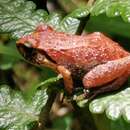Description
provided by AmphibiaWeb articles
Males and females of Eleutherodactylus abbotti are usually characterized by their small size. Males may be measured to 19 mm and females up to 25 mm in the snout-vent length. The patterns on the dorsal side of the species may vary with a variety of designs, yellowish tan to tan is the ground color. In comparison, the postanal area is much darker. Often attached to a dark interocular bar of the dorsal region is a scapular X. A single cural band vaguely bands the hindlimbs. In contrast, E. audanti possesses a similar band, although outlined in pale. Vague stippling is often found on the throat, with the ventral surface immaculate yellow in color.This species account was written based upon the account found in the Catalogue of American Amphibians and Reptiles.KEVIN, cite the author of the Catalogue account by entering the account as a separate publication in our references database. That way, folks will know exactly who wrote the account and how they can find it in a library.
Distribution and Habitat
provided by AmphibiaWeb articles
The species is most widespread on Hispaniola. E. abbotti occurs in wet or mesic forested habitats, although its absence is unexplained in extreme eastern Hispaniola that is primarily a mesic region. In Haiti, the species is known in scattered localities on the Tiburon Peninsula, extreme northern Haiti and in central Haiti near Burrage de Peligre. The species is also widely distributed in the Dominican Republic. The elevation range E. abbotti may be found is from sea level to 6000 ft.
Life History, Abundance, Activity, and Special Behaviors
provided by AmphibiaWeb articles
The call of E. abbotti is characterized by a repetitive series of "tucks" coupled by a "tuck-wheep" that may precede or follow the first note. Rainy, cool, or overcast days are often times when callings may occur. Large numbers of males often compose the choruses of this species. Calling sites are above the surface, usually no more than 4 feet above the ground.
Eleutherodactylus abbotti: Brief Summary
provided by wikipedia EN
Eleutherodactylus abbotti, sometimes known as the Abbott's robber frog, is a species of frog in the family Eleutherodactylidae endemic to Hispaniola (Haiti and the Dominican Republic). It is very common species inhabiting mesic woods and forest and open habitats, including urban areas. Typically it is found under litter, logs and trash.
- license
- cc-by-sa-3.0
- copyright
- Wikipedia authors and editors

